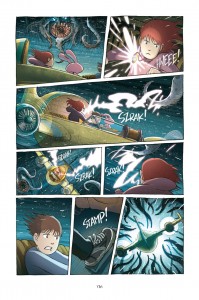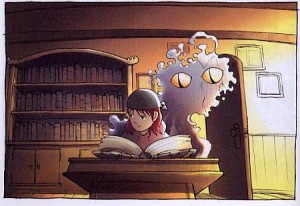Welcome to Using Graphic Novels in Education, an ongoing feature from CBLDF that is designed to allay confusion around the content of graphic novels and to help parents and teachers raise readers. In this column, we examine graphic novels, including those that have been targeted by censors, and provide teaching and discussion suggestions for the use of such books in classrooms.
This post takes a closer look at the Amulet series by Kazu Kibuishi. The ninth and final volume is expected to be published in 2021. This guide was written after the first six books had been published.
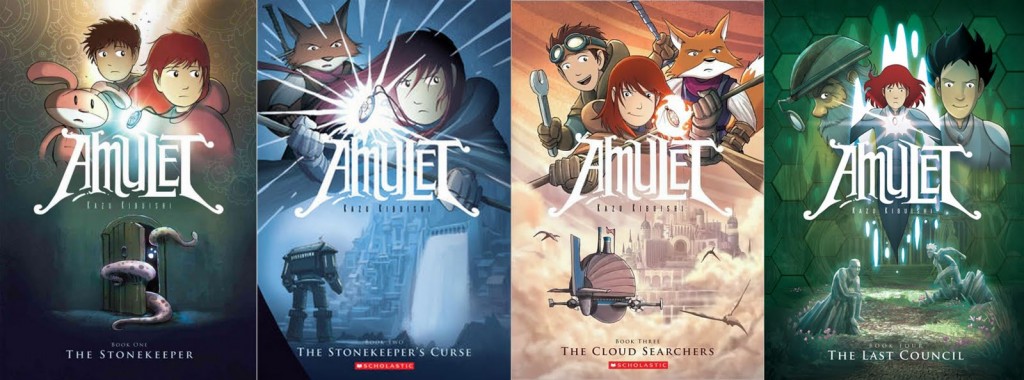
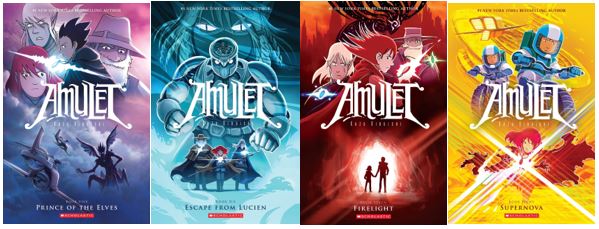
Amulet is an award-winning graphic novel series about Emily and her brother Navin who, through extenuating circumstances, find themselves battling for the freedom of a parallel world and face mounting dangers with newfound friends. This coming-of-age series continues to win awards. The Young Adult Library services Association named it one of Best Books for Young Adults in 2009. In 2010, it won a Rhode Island Children’s Book Award and was included in a Library Journal list of “Graphic Novels for Reluctant Readers.” In 2011, it received a Young Reader’s Choice Award, and in 2013, it was ranked fourth on Goodreads’ “Best Graphic Novels for Children” list. These books received an Eisner nomination and are currently New York Times bestsellers.
The Amulet series includes (to date):
- Amulet Book One: The Stonekeeper (2008)
- Amulet Book Two: The Stonekeeper’s Curse (2009)
- Amulet Book Three: The Cloud Searchers (2010)
- Amulet Book Four: The Last Council (2011)
- Amulet Book Five: Prince of the Elves (2012)
- Amulet Book Six: Escape from Lucien (2014)
- Amulet Book Seven: Firelight (2016)*
- Amulet Book Eight: Supernova (2018)*
- Volume Nine expected in 2021
*note: this guide covers volumes 1-6, although many of the activities will apply to any of the books in the entire series.
Table of Contents
- OVERVIEW
- SUMMARY
- TEACHING/DISCUSSION SUGGESTIONS
- COMMON CORE STATE STANDARDS (CCSS)
- ADDITIONAL RESOURCES
OVERVIEW
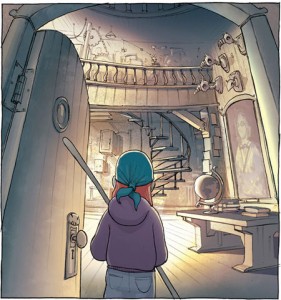 Amulet is about a determined girl named Emily and her younger brother Navin, who move into their great-grandfather’s country house outside a town called Norlen after their father’s death. While the locals believe the house is haunted, Emily and Navin’s mom, Karen, has no choice but to fix up the old house and move in. Times have been hard without their dad, and the home is all they can afford. While cleaning the cobwebs and dust, Emily discovers a locket — the Amulet — and Karen, Emily, and Navin are transported into an alternate world through a small door in the basement. They soon discover that they’re descended from a line of Stonekeepers, people charged with protecting the alien world. They also find shortly after their arrival that something is terribly wrong.
Amulet is about a determined girl named Emily and her younger brother Navin, who move into their great-grandfather’s country house outside a town called Norlen after their father’s death. While the locals believe the house is haunted, Emily and Navin’s mom, Karen, has no choice but to fix up the old house and move in. Times have been hard without their dad, and the home is all they can afford. While cleaning the cobwebs and dust, Emily discovers a locket — the Amulet — and Karen, Emily, and Navin are transported into an alternate world through a small door in the basement. They soon discover that they’re descended from a line of Stonekeepers, people charged with protecting the alien world. They also find shortly after their arrival that something is terribly wrong.
Throughout the series, we learn about Emily’s family’s past, her great-grandfather’s abrupt disappearance, and the power of the Amulet. Emily and Navin, with the help of extraordinary supporting characters, also learn about their own powers — powers to cope, powers to survive, powers to protect others, and powers to grow.
Amulet introduces us to wonderfully faceted characters — robots that bring to mind Star Wars; steampunk robot houses; elves; anthropomorphic foxes, rabbits, and cats; all sorts of flying machines piloted by children and robots; and more. The reader also encounters amorphous voices and characters who feel like pure evil. Amulet’s plot and diverse characters are achieved through rich dialogue as well as lavish art.
Through exciting twists and turns, Amulet deals with familial responsibilities, coming of age, finding the courage to face unwanted challenges, and the importance of teamwork. In each volume we ride a roller coaster of plot twists, along with outstanding art, graphic design, and character development.
These books are geared for kids 7+ and can be easily integrated into language arts and social studies lessons for grades 2-6. That said, they’re wonderfully entertaining for readers of all ages, and would encourage outside-of-school reading.
SERIES SUMMARY
Amulet Book One: The Stonekeeper
This first volume sets the stage for Emily and Navin’s adventure. We learn of their father’s death and their subsequent move to their great-grandfather’s disheveled house. It is here Emily finds the Amulet, and Emily, Navin, and their mom Karen are taken to Alledia, an alternate world. In Alledia, they meet their great-grandfather, Silas Charnon, and his assistants, who help maintain the house in this alternate world. These assistants include Miskit, a talented rabbit, and robots named Cogsley, Ruby, and Morrie. Emily and her family quickly learn that they were destined to save this alternate world from as yet unknown evil.
Amulet Book Two: The Stonekeeper’s Curse
The second volume begins with Emily and Navin’s quest to find an antidote for the arachnopod poison that is killing their mom. Via the magical house (which turns into a robot) they go the nearest city, Kanalis, to find a doctor and a cure. But they are being pursued and hunted by elves. They also quickly discover that the inhabitants of Kanalis are slowly being altered by an ancient curse. As the elves are about to attack, a humanoid fox named Leon Redbeard helps them escape.
Leon and others from the underground help Emily and Navin discover their purpose and strength. Navin learns that he is the general they’ve heard about in prophecies, and Emily learns to wield the powers and secrets of the Amulet as she, Leon, and Miskit trek for the fruit of the alder tree that will save Karen. In her quest for the fruit, Emily faces many challenges, including attacks by the elves. Emily battles Trellis, the son of the evil Elf King, and breaks the stone of his Amulet — one much like Emily’s.
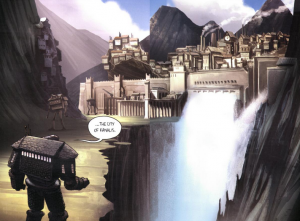
Amulet Book Three: The Cloud Searchers
In this volume, Emily and her crew seek help for Alledia from the Guardian Council’s Storekeepers, who reside in the lost city of Cialis. To find it, they charter an airship piloted by two humanoid cats named Enzo and Rico. Along the way, they find help from Trellis and Luger, two of the elves who had pursued them in Book Two. It seems when Emily shattered Trellis’s Amulet stone, she released a curse. Luger and Trellis believe the fate of the elves rest with their joining forces with Emily and the others.

Amulet Book Four: The Last Council
Upon discovering and arriving at Cielis, Emily and her family are separated from their friends. Emily finds she must compete for a spot on the Guardian Council, a group of the most powerful Stonekeepers. While Emily and her friends and family are separated, they independently discover that the streets are deserted, the townspeople live in fear, and that there are deep, dark dangers and secrets in Cielis. Toward the end of this volume, Emily confronts one of those dangers in the form of Max Griffin, who has stolen the Mother Stone, which is the stone from which all the Amulet stones were cut. While barely escaping Max’s challenges, Emily finds Vigo, a former Stonekeeper of the Guardian Council. Together, they realize that there are great dangers and challenges ahead of them that must be faced if they are to restore peace and order to the world.
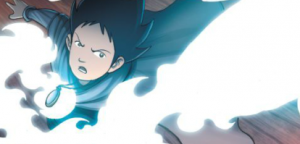
Amulet Book Five: Prince of the Elves
Knowing that Max has stolen the Mother Stone and taken it to the Elf King to forge new Amulets, Vigo and Emily face growing dangers as they try to stop the Elf King. The Cielis Guard (what’s left of the Cielis army) prepares to fight the elf army, but the enemy is getting stronger and the Elf King has begun to use the shard of the Mother Stone to create his own Guardian Council. As both sides prepare for war, Trellis and Emily (with the help of Vigo and others) discover that the stone allows them to go into the past. Emily, while always wary of the voice in the stone, is finding new evidence to support her misgivings. She and Trellis go into the past and find that Max is not exactly what he seems to be and that he has been controlled by the Voice of his Amulet. Emily also discovers that the Voice of her Amulet is more sinister than she originally feared.
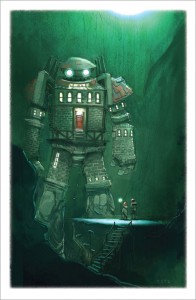
Book Six: Escape From Lucien
Navin is training with students of the Cielis Guard and despite being appointed a general in Book One, he must prove himself to instructors of the Cielis Guard. Navin and his classmates journey to Lucien, a city ravaged by war and plagued by ghost-like creatures. In Lucien, they search for a beacon that is crucial for their battle against the Elf King. Meanwhile, Emily must go back in time again, this time with Max. Max has learned that Emily released the Voice spell from Trellis’s Amulet stone and asks her to help him as well. He tries to convince them that he is actually fighting for the elf nation and that things still are not as they appear to be.
NOTE: two additional volumes of Amulet have been published since this guide was developed.

In short, Amulet is a about finding the courage and the means of facing one’s challenges and fears. It’s a series about heroes and responsibility and learning to trust. It’s a series about the benefits of teamwork when facing the challenges of growing up.
Throughout the series readers learn:
- How to accept and meet the burdens and challenges of responsibility to one’s family and one’s community;
- How to balance meeting and falling short of expectations;
- How to accept fate while facing and navigating fears;
- How to recognize and accept given gifts and skills while balancing goals and expectations;
- How to learn to use your strengths and skills while accepting help from others when those strengths and skills are not enough;
- How to figure out what it takes to be a hero.
Amulet’s themes include:
- The power and importance of friendship;
- The power and importance of family and strong sibling relationships;
- The pressures and challenges of living up to expectations;
- The pressures of juggling fate, circumstances, fears, and realities when problem solving;
- Finding the resources and courage to face and overcome fears;
- Realizing that success entails dedication, creative problem solving, and teamwork;
- Learning to recognize good versus evil and understanding that things aren’t always as they seem.

TEACHING/DISCUSSION SUGGESTIONS
Plot, Themes, and Values Related
- In each volume, Emily and Navin must overcome challenges. Plot the challenges each face and the strategies they use when facing them. Discuss and evaluate the effectiveness of their strategies. Brainstorm your own. You may want to do this for Trellis and Max as well.
- Over the course of the series, discuss how Emily and Navin have changed. Have students bring in evidence to support their positions.
- Over the course of the series, we frequently question the motivations of Trellis and of Max. Discuss why Kibuishi has us question their motives, and discuss how Kibuishi creates these ambiguities.
- In each book the characters are forced to make decisions and must then deal with the consequences. Plot the decisions and consequences of the characters’ actions. What can you learn from them?
Critical Reading and Making Inferences
- Search and discuss the many truths Emily and Navin learn in each book. For example:
- In Book One: The Stonekeeper (p. 72), the Voice tells Emily, “Being a Stonekeeper is a responsibility you mustn’t take lightly.” What might these responsibilities be? Why can’t they be taken lightly?
- In Book Two: The Stonekeeper’s Curse (p. 99), Leon Redbeard and Emily discuss the choices she is facing. Discuss what Leon means when he says, “You must believe that you are here by choice and not by circumstance…You must…take control of your life and the stone will follow.” What might Leon’s implications entail?
- In Book Two: The Stonekeeper’s Curse (p. 125), Leon tells Emily and Navin why he’s helping them: “I am not motivated by vengeance. I do this to honor him.” What does Leon mean by this? How does Leon’s helping Emily and Navin help honor his father?
- In Book Three: The Cloud Searchers (p. 145), Mom tells Emily that, “If you can find the confidence to trust yourself, you can make it through any situation, no matter how bad things seem.” Discuss how confidence can help you through situations. Give specific examples.
- In Book Four: The Last Council (p. 38-39), Mom tells Emily that, almost everywhere you go in life, “…you’re going to find something wrong with the place. That’s the way life is… You just have to be willing to follow their systems and do what you can to make things right.” Have students explain this and come up with examples of how in school and in their extended communities they can try to ‘make things right.’
- In Book Five: Prince of the Elves (p. 58), Vigo tells Emily that, “Sometimes personal desires and ambitions can cloud the judgment of even our brightest minds.” Explain what Vigo might mean, giving examples to support your interpretation.
- In Book Six: Escape From Lucien (p. 20), Leon tells Emily to trust her instincts and to “Just remember that these people need your help to begin with… not making decisions can be the worst decision of all.” Have students explain what Leon means, giving examples to support their opinions.
Language, Literature, and Language Usage
- Language Usage: Search, chart, and discuss literary devices used in Amulet. You may want to compare other ways to write the same ideas in an effort to show the value of these devices.
- Creative Writing
- In Book One: The Stonekeeper (p. 67), Emily and Navin escape a monster by jumping off a cliff and using large mushrooms as “sails.” Write how it might feel to parachute with a mushroom.
- In Book One: The Stonekeeper (p. 100), Grandfather Silas says “…the power of the Amulet can give power to turn back time…the power to shape your world.” What might you go back in time for and what might you change? How and why would you change it?
- Literature: In Book Two: The Stonekeeper’s Curse (p. 95), Leon Redbeard discusses the choices Silas had and made. Discuss Silas’ and Emily’s choices. Then read and analyze Robert Frost’s The Road Not Taken. Discuss how this poem relates to this scene here in Amulet.
- Literary Devices
- Foreshadowing can be found in each of the volumes both in the text and the images. Search for and discuss examples of foreshadowing and have students create their own examples. For example, in Book Three: The Cloud Searchers (p. 150), Leon sees a dragon like monster and then (p.151) says, “I get the feeling we’re not the only ones out here…”
- Puns and idioms are rife in these books. Search, define, and discuss these literary devices and have the class brainstorm others.
Modes of Storytelling and Visual Literacy
In graphic novels, images are used to relay messages with and without accompanying text, adding additional dimension to the story. In Amulet Kibuishi weaves a story, full of emotions and insights through the use of text, image and design. For example:
- Chart and analyze and discuss how Kibuishi uses color, font, and design to separate scenes. Discuss the effectiveness of these visual cues.
- Chart, analyze, and discuss how balloon shapes and font styles and sizes are used to relay information.
- Chart and analyze how flashbacks, dreams, and conversations with the Voice are created through the combination of image, design, and text.
- Chart and analyze how Mr. Kibuishi uses color schemes to help distinguish and shift scenes.
- In Book Five: Prince of the Elves, we meet Chronos, a monster Max rescues to help him. Discuss the form and design Kibuishi uses to make Chronos appear so formidable. Have students draw and explain their own worst nightmares / monsters.
Content-Area Lessons
- Social Studies: Compare and contrast the way the cities of Cielis, Alledia, Lucien and Kanalis are designed, run, and maintained. Ask students: How are these cities and the daily lives of their inhabitants similar and different from where you live?
- Social Studies: In Book Four: The Last Council (p. 38-39), Karen tells Emily that almost everywhere you go in life, “…you’re going to find something wrong with the place. That’s the way life is… You just have to be willing to follow their systems and do what you can to make things right.” Discuss how different systems of government do and do not encourage and empower their citizens to “make things right.”
- Social Studies: In Book Four: The Last Council (p. 81), Vigo recounts how Silas criticized the Council for making decisions based on its fears. Discuss how political and social decisions are made and why making decisions from fears may or may not be the best way to legislate.
- Social Studies: In Book Five: Prince of the Elves (p. 22), we see a flashback of Max Griffin before the Guardian Council. He is being sentenced “…to fifty years in the ice prison of Korthan for aiding in the escape of war prisoners. You will also face trail in prison for your actions leading to the deaths of four soldiers….” Discuss whether this sentencing and punishment is just or unjust (giving examples to support your opinions). You may also want to discuss the choice of location for Korthan (and other) prisons.
- History/Social Studies: In Book Five: Prince of the Elves (p. 58), Vigo tells Emily that, “Sometimes personal desires and ambitions can cloud the judgment of even our brightest minds.” Have students search for examples in history that support Vigo’s statement.
- History/ Social Studies: In Book Six: Escape from Lucien we meet the Resistance Army. Discuss why it is called a “Resistance Army” and compare this army (its structure, goals, and missions) to resistance armies throughout history.
- Science: In Book One: The Stonekeeper, Karen is stung by an “arachnopod.” In Book Two: The Stonekeeper’s Curse (p. 40-41), we learn a little more about arachnopods.
- Using this name, have students create their own field guide for identifying arachnopods and curing their lethal stings.
- Have students create their own original deadly animals with names based on existing scientific taxa. Have students describe what these animals look like, where they live, what their deadly powers might be, and what we might do to protect ourselves from those deadly powers/threats.
Suggested Prose Novel and Poetry Pairings
For more fun or if seeking resources for deeper literary analysis, here are some books/poems similar to Amulet that we’re sure you’ll enjoy.
- Zita: Space Girl by Ben Hatke: A graphic novel series about a young girl who is also is transported into an alternate world, and reluctantly finds herself a hero.
- A Wrinkle in Time by Madeleine L’Engle: A book in which a brother and sister must travel to an alternate world to find and rescue their scientist father.
- The Road Not Taken by Robert Frost: A poem about choices one must make.
- The Hobbit by JRR Tolkien: A book in which a humble hobbit must join with forces with elves, dwarfs, and others to go on an adventure and save Middle Earth.
- The Harry Potter series by JK Rowling: A coming-of-age series with magic, adventure, good, and evil.
- Alice in Wonderland by Lewis Carroll: A story in which a girl falls through a rabbit hole and finds herself in an alternate reality.
- The Lion, The Witch and The Wardrobe by C.S. Lewis: A book in which siblings transport through a wardrobe into an alternate world that they must save from an evil queen.
- The Oz series by L. Frank Baum: Including the Wonderful Wizard of Oz, this series follows the adventures of several children, including Dorothy, in the magical Land of Oz.
COMMON CORE STATE STANDARDS (CCSS)
While this book is written for young readers (with a Grade 2-5), and suggested for elementary school classrooms, it can be incorporated into language arts and content-area classes for a variety of grades. I therefore will be using the Common Core Anchor Standards for College and Career Readiness for Reading, Writing, and Speaking and Listening. Reading Amulet and incorporating the teaching suggestions above promotes critical thinking and its graphic novel format provides verbal and visual story telling across subject areas while addressing multi-modal teaching. Here’s a more detailed look:
- Knowledge of Language: Apply knowledge of language to understand how language functions in different contexts, to make effective choices for meaning or style, to comprehend more fully when reading or listening.
- Vocabulary Acquisition and Use: Determine or clarify the meaning of unknown and multiple-meaning words and phrases by using context clues, analyzing meaningful word parts, and consulting general and specialized reference materials; demonstrate understanding of figurative language, word relationships, and nuances in word meaning; acquire and use accurately a range of general academic and domain-specific words and phrases sufficient for reading, writing, speaking and listening at the college and career readiness level.
- Key ideas and details: Reading closely to determine what the texts says explicitly and making logical inferences from it; citing specific textual evidence when writing or speaking to support conclusions drawn from the text; determining central ideas or themes and analyzing their development; summarizing the key supporting details and ideas; analyzing how and why individuals, events, or ideas develop and interact over the course of the text.
- Craft and structure: Interpreting words and phrases as they are used in a text, including determining technical, connotative, and figurative meanings and analyzing how specific word choices shape meaning or tone; analyzing the structure of texts, including how specific sentences, paragraphs and larger portions of the text relate to each other and the whole; Assessing how point of view or purpose shapes the content and style of a text.
- Integration of knowledge and ideas: Integrate and evaluate content presented in diverse media and formats, including visually…as well as in words; delineate and evaluate the argument and specific claims in a text, including the validity of the reasoning as well as the relevance and sufficiency of the evidence; analyze how two or more texts address similar themes or topics in order to build knowledge or to compare the approaches the authors take
- Range of reading and level of text complexity: Read and comprehend complex literary and informational texts independently and proficiently
- Comprehension and collaboration: Prepare for and participate effectively in a range of conversations and collaborations with diverse partners, building on others’ ideas and expressing their own clearly and persuasively; integrate and evaluate information presented in diverse media and formats, including visually, quantitatively and orally; evaluate a speaker’s point of view, reasoning, and use of evidence and rhetoric.
ADDITIONAL RESOURCES:
- http://www.scholastic.com/amulet/ is an interactive webpage by Scholastic with some awesome sound effects and links to explore the books, meet the author and meet the characters of Amulet. Note, however, that there are some spoilers so go play and explore AFTER your read the books.
- https://www.youtube.com/watch?v=5Zji2QcW0Io — Kibuishi gives a workshop on how he draws and creates graphic novels.
- https://www.youtube.com/watch?v=9jA-jMpccRU (Part 1) — Watch a video interview with Kazu Kibuishi on the art of graphic novels (sponsored by Illustration.org). Learn how students have influenced the course and feel of Amulet.
- https://www.youtube.com/watch?v=OcNyqTde0Ns — Watch a video interview with Kazu Kibuishi on the process of making Amulet.
Meryl Jaffe, PhD teaches visual literacy and critical reading at Johns Hopkins University Center for Talented Youth OnLine Division and is the author of Raising a Reader! and Using Content-Area Graphic Texts for Learning. She used to encourage the “classics” to the exclusion comics, but with her kids’ intervention, Meryl has become an avid graphic novel fan. She now incorporates them in her work, believing that the educational process must reflect the imagination and intellectual flexibility it hopes to nurture. In this monthly feature, Meryl and CBLDF hope to empower educators and encourage an ongoing dialogue promoting kids’ right to read while utilizing the rich educational opportunities graphic novels have to offer. Please continue the dialogue with your own comments, teaching, reading, or discussion ideas at meryl.jaffe@cbldf.org and please visit Dr. Jaffe at http://www.departingthe text.blogspot.com.
Please help support CBLDF’s important First Amendment work by making a donation or becoming a member of CBLDF!
All images (c) Kazu Kibuishi.


